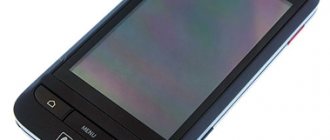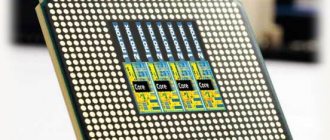A short story in simple language about the cores of mobile processors, their functions and the required quantity.
For any person who decides to get a brand new smartphone, the main selection criterion is not only the price, but also the power of the gadget. If you go to the website of some online store and open the technical characteristics of smartphones, then among them you can see such a definition as “processor”.
Many, even technically illiterate users, are familiar with this part and have an idea of what function it performs. However, the words “dual-core” or “quad-core” next to it cause confusion among many.
In our article we will talk about what a processor core is in a smartphone, what it is responsible for, and whether the opinion is true that the more cores in the processor, the more powerful the phone.
Image 1. What is the central processing unit core in a phone, what is it responsible for and what function does it perform?
Processor manufacturers
What are the best processors for smartphones? There is no clear answer to this question. It is worth noting one of the leaders in the production of microchips. This is the Qualcomm company, which developed such bestsellers as Snapdragon 400, 600 and 800. Apple Corporation designs processors independently for its devices using ARM architecture. The Korean brand Samsung has also developed Samsung Exynos microchips, which are installed on the company's TOP smartphones. The Chinese company MediaTek, which is confidently mastering the modern market, is also worthy of special attention. It is worth mentioning the Intel brand, which produces processors based on the x86 architecture, used for the development of computer microchips. The products of this manufacturer are mainly used in Windows devices.
Exynos 2100
Samsung processor, found only in its devices.
| Options | |
| Cores | 8 (1x2.9, 3x2.8, 4x2.2 GHz) |
| Tehnorma | 5 nm |
| AnTuTu | 676k |
| Year of issue | 2020 |
By a surprising coincidence, the Exynos 2100 is architecturally no different from the Snapdragon 888. And although it uses more overclocked energy-efficient cores, in AnTuTu the results are lower and the energy efficiency is better. This collision is difficult to explain logically, especially if you remember the characteristics of previously released Samsung chipsets. Exynos 21000 is a pleasant exception, which is difficult to find fault with.
Pros:
- optimization;
- performance;
- allows you to record 8K video (60fps).
Minuses:
- found only on Samsung.
Processor frequency: which is better for a smartphone?
When choosing a smartphone, you should not focus on clock speeds. But the higher the numbers, the better it is. Almost all processors for mobile phones have the ability to automatically adjust their own frequencies. Therefore, the characteristics of a smartphone or tablet indicate the upper figure. The bulk of smartphones have processors with the following ranges:
- 1000-1300 MHz for budget models;
- 1300-1700 MHz for the middle class;
- 1900 MHz is the most powerful processor for a smartphone or tablet.
It is important to understand: megahertz on one device can “show themselves” faster than on another. The performance speed of a gadget is influenced not only by frequency, but also by many other parameters. To determine the speed of the processor, special programs have been developed that can be used to compare the performance of smartphones. Under any circumstances, it is better to choose a processor for a smartphone with a microchip with a frequency of at least 1500 MHz.
What are neural processing units used for?
Neural processing units are already being widely implemented in systems on chips. Neural processors are used to process mathematical algorithms, calculations and are used to operate neural networks. NPUs are designed to perform neural network tasks much faster than a classic CPU. They use their own memory, without accessing the RAM, in order to speed up the execution of work.
Firstly, neural networks in smartphones are used to train the operating system; the OS learns by remembering the behavior (use of the smartphone) of the user. The smartphone learns by remembering your behavior, what applications you use, how often you launch this or that program. Secondly, machine learning is used to achieve better photo quality. This is another reason why Huawei flagships have become so cool to photograph, all thanks to the upgraded NPU in the Kirin 990.
How many cores are needed for the device to function effectively?
On the modern market there is a huge number of multi-core processors that use several computing units for different tasks. After the creation of dual-core microchips, four-, five- and eight-core solutions also began to appear on the market. When buying a mobile device, the choice may seem obvious, based on the principle - the more cores, the better. But it is not always the case. Smartphone processors almost never use all cores to launch and operate applications, for most of which a dual-core chip is sufficient. A clear indication of this is the latest version of the iPhone, which uses a dual-core processor. Correct and high-quality optimization allows the gadget to function at the highest level, and the performance of this device will be the envy of many devices, even with eight-core microchips.
It is worth paying attention to the Samsung Exynos 5 processor, which is equipped with some models of the brand’s gadgets. It has eight cores thanks to two quad-core microchips that do not function simultaneously. One of the processors is more powerful and starts when opening “heavy” games and applications. At the same time, he is quite “voracious”. The rest of the tasks are performed by a more energy-efficient chip, which conserves battery power and is capable of delivering excellent performance for less complex applications.
Don't know how to choose a good processor for your smartphone? When purchasing a budget device, a dual-core chip will be enough. If you are passionate about games, you should pay attention to quad-core variations. An eight-core processor is, of course, good, but there is practically no use for it yet. When it becomes possible to use such gadgets, modern premium smartphones will cost the same as budget models.
A13 Bionic
Not the newest solution from Apple, noticeably inferior to the leaders in the ranking in terms of performance.
| Options | |
| Cores | 6 (2×2.66, 4×1.6 GHz) |
| Tehnorma | 7 nm |
| AnTuTu | 526k |
| Year of issue | 2019 |
Optimization of the A13 Bionic does not give a single reason to find fault with the processor. But don’t assume that this is the optimal solution for 2022. AnTutU testing results show that the chipset lags far behind the leaders, and the 7 nm technology hints at excessive heating. At the same time, not a single owner of a smartphone based on it doubts the reliability of the processor.
Pros:
- optimized software for A13;
- reliability;
- graphics chip.
Minuses:
- Apple only;
- loss in productivity;
- no 5G.
Which processor is better for an Android smartphone?
Most Android devices are powered by Snapdragon microchips manufactured by Qualcomm. With a sufficiently significant load, the gadget will work at full power, which is indicated in its characteristics. And when idle, operating frequencies will be reduced to save battery.
It would be wrong to say that Snapdragon is the best processor for an Android smartphone. But the popularity of installing it on most devices is quite high.
The speed of a smartphone is influenced by three factors - the processor, the graphics core and RAM. Since the graphics core is often combined with the processor, and RAM itself has minimal impact, special attention should be paid to the choice of processor for a smartphone.
Let's look at the main characteristics and the most common processor models for smartphones.
Chinese manufacturers are used to boasting that their smartphones are powered by 8-core processors, and uninformed consumers are impressed. However, in reality, the number of cores is not the most important indicator of device performance. To solve everyday problems, two cores may be enough for the consumer. The example of Apple is indicative: the latest devices of this company operate on a dual-core A8 chip, but in terms of speed the iPhone will give the same performance to all “Chinese”.
The meaning of the kernels can be described as follows. Previously, all smartphone commands were executed sequentially, and therefore manufacturers sought to increase the clock frequency of the phone's processor, however, now the so-called era of parallelization has arrived. Each core of a modern smartphone can perform several functions, and the smartphone itself can perform millions of operations simultaneously. Streams of information no longer have to be queued, and this increases the speed of the gadget. However, to baffle even a dual-core chip, the user will have to try hard.
What is eight-core?
The term " octa-core"
" is somewhat confusing, but it actually means duplication of quad-core processors. The result is two independently operating quad-core sets, combined into one chip to improve energy efficiency.
Interesting materials:
Severe lumbago in the lower back, what should I do? Severe lumbago in the lower back, what should I do? Blue screen on computer, what to do? Siri does not respond with a voice, what should I do? Android system memory is full, what should I do? The phone's system memory is full, what should I do? How to make a Skype conference? Skype can't connect, what should I do? Skype has no sound, what should I do? Skype can't connect, what should I do?
Frequency
The processor frequency affects the number of operations performed per second. The higher the processor frequency, the faster the queue of smartphone commands, which was mentioned earlier, moves. Over time, the role of processor frequency becomes secondary due to the fact that the number of cores comes to the fore. However, this point is important: a multi-core processor can speed up the operation of a gadget only if the information is divisible. If the information is indivisible, then even in an 8-core processor only one core will work, and its performance will be equal to the clock frequency.
That is why you should focus on the needs: users who work with graphics, music, video files need a multi-core smartphone, while gamers should pay attention to the frequency - programmers do not always provide for the fragmentation of software processes.
Snapdragon 870
Qualcomm's sub-flagship solution, which is an alternative to the controversial Snapdragon 888.
| Options | |
| Cores | 8 (1x3.2, 3x2.42, 4x1.8 GHz) |
| Technical process | 7 nm |
| AnTuTu | 643k |
| Year of issue | 2021 |
Unlike its older brother, it uses the technology of the previous generation. However, this has virtually no effect on its energy efficiency. Smartphones with Snapdragon 870 hold a charge well and do not heat up to critical temperatures. However, there is insufficient performance for gaming at maximum graphics settings.
Pros:
- optimization;
- high core frequency;
- 8K support.
Minuses:
- 7 nm technical process.
The best processors for smartphones
- Qualcomm
is a company that produces not only the famous Snapdragon chips, but also the development of key technologies, such as LTE. Processors from Qualcomm are used by such large manufacturers of mobile equipment as HTC, Samsung and Sony (Xperia Z line). The latest top-end chip, the Snapdragon 810, faced criticism for being expensive and overheating, but this did not affect the overall popularity of Qualcomm products. - MediaTek
is Qualcomm's main industry competitor. The company focuses on the optimal price-quality ratio, and therefore smartphones with a processor from MediaTek, when compared with analogues, are simply cheaper. It is noteworthy that it was MediaTek that was the first to develop the 10-core Xelio X processor. The company's products are used, in particular, by the Chinese giant Lenovo. - Samsung is
actively developing its own Exynos line. The 8-core Exynos 7420 is found in the latest models of Samsung smartphones, for example, in the S6 Edge. - Intel
is the leader among manufacturers of processors for laptops, but in the mobile development industry this company is in the second tier. Intel Atom powers the Asus Zenfone line, a number of Lenovo models, and some smartphones from other little-known manufacturers.
Kirin 9000E Er
Another sub-flagship solution, but from HUAWEI.
| Options | |
| Cores | 8 (1x3.13, 3x2.54, 4x2.05 GHz) |
| Tehnorma | 5 nm |
| AnTuTu | 622k |
| Year of issue | 2020 |
When developing the Kirin 9000E, all modern requirements were met, including the 5-nanometer process technology. The performance also keeps up with energy efficiency indicators, but the graphics capabilities are far from ideal. Therefore, in complex games, fps drops often occur.
Pros:
- 5nm transistors;
- three-cluster system;
- does not greatly affect the operation of the battery.
Minuses:
- designed for HUAWEI and HONOR;
- not suitable for heavy games.
Processor comparison
We have compiled all the basic characteristics that are important for the user into a table that will help you choose the right option. This includes the most common chips from well-known manufacturers over the past 2-3 years, which have not yet lost their relevance.
| Model | GPU | Cores | Frequency (GHz) | Process technology (nm) | release date |
| Snapdragon 835 | Adreno 540 | ||||
| Snapdragon 821 | Adreno 530 | ||||
| Snapdragon 820 | Adreno 530 | ||||
| Snapdragon 810 | Adreno 430 | ||||
| Snapdragon 808 | Adreno 418 | ||||
| Snapdragon 650 | Adreno 510 | ||||
| Snapdragon 625 | Adreno 506 | ||||
| Snapdragon 430 | Adreno 505 | ||||
| MT6797T Helio X25 | Mali-T880 MP4 | 1,55+2+2,5 | |||
| MT6797 Helio X20 | Mali-T880 MP4 | 1,4+1,8+21 | |||
| MT6757 Pro/Helio P25 | Mali T880 MP2 | ||||
| MT6755(M)/Helio P10 | Mali T860 MP2 | ||||
| MT6738(T) | Mali T860 MP2 | ||||
| Kirin 960 | Mali-G71 MP8 | ||||
| Kirin 955 | Mali-T880 MP4 | ||||
| Kirin 935 | Mali-T628 MP4 | ||||
| Exynos 8895 | Mail-G71 MP20 | ||||
| Exynos 8890 | Mali T880MP12 | ||||
| Exynos 7880 | Mali-T830 MP3 | ||||
| Exynos 7870 | Mali-T830 MP3 | ||||
| Exynos 7580 | Mali-T720 MP2 |
Another convenient way to compare mobile processors is their performance graphs. In the figure below you see the top devices from the Antutu benchmark as of the end of 2016 and beginning of 2017.
So
, when choosing a mobile processor, first of all, we pay attention to the manufacturer (we listed the most reliable ones above), the clock frequency of the productive cores, and the presence of heating. Everything else is technical subtleties that there is no point in delving into for the average user (and if you are not an average user, you have not learned anything new from this text). It is enough to be guided by a simple rule: the flagship models here collect all the best, there are no problems with them (with rare exceptions), they are needed, first of all, by gamers and enthusiasts. For example, Google Daydream is only compatible with advanced processors. Modern “average” devices also cope with applications and games, including three-dimensional ones, without any problems. As for the entry-level, you will have to make compromises, but it is much better if it is a low-power but reliable chipset from a renowned manufacturer than a homemade noname from which you can expect anything.
Gone are the days when most owners of mobile gadgets were aware of what the phrase MediaTek was. But even the cohort that was still called about this processor - the associations were not very cheerful, and were mainly related to the “glitches” of the system.
But, after a couple of years, the Chinese manufacturer still decided to produce processors that, in terms of their functionality, became a completely competitive category in the mobile chip market. In turn, such a “technological” leap provoked serious interest from many mobile device manufacturers.
At the same time, the American Qualcomm did not sit idle. To begin with, it pushed Texas Instruments out of the domestic market. And now, Qualcomm and MediaTek are the flagships of the mobile chip market for various smartphones. But which company is better? We'll find out in our article.
A14 Bionic
Apple chipset designed specifically for the iPhone 12 line.
| Options | |
| Cores | 6 (2×3.1, 4×1.8 GHz) |
| Technical process | 5 nm |
| AnTuTu | 604k |
| Year of issue | 2020 |
Unfortunately, this single-chip system, like any other Apple SoC, is used only on devices of the American company. That is, they are not available on Android. However, the A14 is a powerful and energy-efficient processor. And if you are looking for a chipset for an Android smartphone, then it is better to choose one of the options from other manufacturers.
Pros:
- energy efficiency;
- power of productive cores;
- stability.
Minuses:
- not suitable for Android.
Similarities between Qualcomm and MediaTek
As you know, both companies are engaged in the manufacture of mobile processors. But neither Qualcomm nor MediaTek manufacture chips themselves. In this matter, they are helped by specialized companies, such as TSMC. This company is one of the world leaders in the number of factories where mass production of translucent crystals has been established.
Chips from both manufacturers are created for mobile gadgets of any price and functionality. The last similarity is the presence of ARM architecture in the processor.
Pros and cons of Qualcomm chips
Let's start with the pleasant things:
- The finest manufacturing process.
Statistics of chips released annually eloquently indicate that the developer strives for high rates of architecture update. This is manifested, for example, in the policy of installing newly released processors on flagship models, and only then on more budget ones;
- Personal graphics subsystem.
The Adreno graphics accelerator, developed within the walls of this corporation, is responsible for the graphics in Qualcomm processors. This helps adapt their chips to global technological standards much faster than competitors;
- Using your own kernels.
During the release of new SoCs, Qualcomm technologists do not sleep, but buy the rights to this system and modify it in every way to meet the standards of their processors, which helps to increase the performance of each Qualcomm chip;
- Technology for optimizing energy consumption.
Energy efficiency is one of the important criteria in the work of Qualcomm employees, who try to equally distribute the share of productivity and energy efficiency.
Minuses:
- Decent price.
The use of the most advanced technologies will certainly lead to an increase in the price of the processor;
- The intricacy of the internal structure of the bootloader.
It is Qualcomm's chip system bootloaders that are considered the most complex and intricate;
- Limited number of budget versions.
The company's policy is flagship models, which means that most of the market for relatively inexpensive devices is simply bypassed.
Positive aspects of MediaTek chips
- Low cost.
From the very beginning of its production, the company consolidated the pricing policy of processors in the middle category and firmly “holds” its position;
- Good assortment.
Developers from MediaTek are seriously concerned about the quality of their products, which affects the annual update of their model range;
Negative aspects of MediaTek chips:
- Application of basic Cortex cores.
Since the company does not have the means to improve the microarchitecture of its processors, and has to use classic cores for chips;
- Low level of support for the creators.
Unfortunately, issues related to high-quality and reliable developer support for MediaTek are at the forefront. This, in turn, often leads to such issues as untimely updating of drivers in mobile gadgets;
- Loss of leading positions in terms of improving technological processors.
Saving is an attribute of all things from MediaTek. The company's production process does not have direct access to the most modern conveyor lines, which means that all of the company's chipsets are outdated and "rough".
In conclusion, it is worth pointing out that the choice between Qualcomm and MediaTek is a matter that directly depends on the will of the consumer, who purchases this or that mobile gadget based on his preferences and requests.
If our article interests you, like and repost on your social networks!
In this article, the story will not be about the appearance of the devices and ease of use, nor about how the keys and elements on the case should be located. Here I will try to tell you how to choose a smartphone or tablet based on the filling - processor, memory, graphics core.
The Android operating system is so popular that devices running it are produced not only by famous manufacturers, but also by many little-known companies. Fewer companies produce processors for devices running Android, but there are a huge number of chips - single-core, dual-core, quad-core and even eight-core. Smartphones and tablets, among other things, have different amounts of memory from 256 megabytes to 3 gigabytes, and, most importantly for Android games, different graphics processors.
Let's look at a few famous claims:
More memory - faster Android
If we are talking about RAM, then this is true, because the larger the amount of memory, the less the Android operating system needs to access the internal storage, the speed of which is several times lower than the speed of RAM.
More cores - faster Android
If we are talking about identical chips with different numbers of cores, then yes, the more cores, the faster the system. But!
If we are talking about different chips from different manufacturers, then the number of processor cores for Android does not play a decisive role
. For example, my dual-core SONY Xperia SP smartphone is noticeably faster in performance than some quad-core devices.
8 cores are faster than 4
As for 8-core processors, in reality there are few of them. And many eight-core processors are actually two quad-core processors running separately. One more powerful one turns on under heavy load - for example, games, watching videos, heavy applications, and the second one works for light tasks. This scheme is needed to increase the battery life of Android devices.
More processor frequency - faster Android
Here the situation is the same as in point 2. If this is a processor of the same series, from the same manufacturer, then an increase in frequency leads to an increase in the speed of the Android device. But processors, for example MediaTek and Qualcomm, at the same frequency can show different results.
The newer the Android version, the better.
With each new version, Android becomes more functional, additional features and capabilities appear. But the programmers of the Android project, without a doubt, not only add functionality, but also improve and optimize the kernel of the Android operating system. Therefore, yes, the newer the Android version, the better.
My SONY Xperia SP initially had Android 4.1, then it was updated to version 4.3 and the phone began to work noticeably faster, and rare interface lags disappeared. It’s just a pity that the Android 4.4 update will not be released for the Xperia SP, more details.
What else is important for performance?
Ads for Android phones and tablets usually focus on the amount of memory and the number of processor cores, but rarely mention the graphics processor. Namely, the performance of an Android phone or tablet in games depends on the graphics chip.
Custom kernel - what is it used for?
The Android operating system has many modifications, but there are not so many official firmwares. Imagine the situation - a bunch of manufacturers, different models with different technical characteristics. How does the kernel work in this situation? Will it be possible to simultaneously adapt to a budget phone and a flagship smartphone? Of course not.
That is why, individually customized modifications for specific devices, taking into account the features of the device - camera, screen size, battery capacity, etc.
Unfortunately, not all brands do this. In order not to waste time creating the optimal option, they simply trust the operation of the device to the stock (universal) kernel. The advantages of such a solution are obvious - budget savings. But there is a minus for users - some of the device’s capabilities are not used to the maximum (the processor frequency is limited, Android does not see the entire amount of RAM, the cool camera takes pictures worse than promised).
Fortunately, the above described happens extremely rarely and is typical for little-known brands. Self-respecting companies will never allow this to happen, because it will certainly affect their reputation and sales.
In addition, there are enthusiasts who independently “disassemble” the kernel, make adjustments to add useful features (processor overclocking, power management, etc.), then put everything back together and offer to download and install along with custom firmware for specific device model. If you decide to use alternative solutions, remember:
Which phone to buy so that it is fast
After reading everything above, many may have a question about which phone or tablet to buy so that it is fast enough. Perhaps one of the readers is planning to change their phone and wants to know how much faster the new phone will be than the old one.
Testing the phone
A special test called Antutu Benchmark will help you determine how powerful your phone is. It checks the operating speed of each smartphone component and, based on the test results, gives the Android device a final score.
Just compare this score for different phones and find out which one is more powerful, and approximately how much more powerful. In addition to assessing the power of the phone, in the Antutu Benchmark application you can see detailed information about the device - processor model, graphics core model, screen resolution, installed sensors and much more.
Here is a demonstration of the application interface and a test in Antutu Benchmark 5
Exynos 1080
A rare Samsung processor, considered a sub-flagship solution.
| Options | |
| Cores | 8 (1x2.8, 3x2.6, 4x2 GHz) |
| Technical process | 5 nm |
| AnTuTu | 624k |
| Year of issue | 2020 |
Even if this is not the most powerful hardware of the Korean company, it demonstrates good optimization due to the current technical process. The results of AnTuTu also force us to pay tribute to the developers. But what you can and should find fault with is the lack of support for 8 GB of RAM.
Pros:
- energy efficiency;
- optimization;
- performance.
Minuses:
- used only in Samsung;
- Does not support 8GB RAM.
Dimensity 1200
An even more powerful processor, but with the same problem, which is poor game optimization.
| Options | |
| Cores | 8 (1x3, 3x2.6, 4x2 GHz) |
| Tehnorma | 6 nm |
| AnTuTu | 618k |
| Year of issue | 2021 |
Unlike Dimensity 1100, this SoC has a more modern three-cluster core architecture. This allowed for increased productivity. Yes, the increase is not the largest, but when compared head-to-head, the difference becomes obvious.
Pros:
- energy efficient solution;
- power;
- main core frequency.
Minuses:
- game optimization.
Snapdragon 865 Plus
Last year's processor, which was the most productive at the time of release. By the way, even now the capabilities of the Snapdragon 865 Plus should be called sufficient to solve most problems.
| Options | |
| Cores | 8 (1x3.1, 3x2.42, 4x1.8 GHz) |
| Technical process | 7 nm |
| AnTuTu | 604k |
| Year of issue | 2020 |
Traditionally, the 8-core chipset is made using a three-cluster architecture. But the year of release seems to hint that the developers did not have the opportunity to switch to the 5-nanometer process technology. Therefore, the energy efficiency of the SD870 is not as impressive.
Pros:
- high frequency;
- current interfaces;
- powerful graphics.
Minuses:
- 7 nm technical process.
Exynos 990
Perhaps the most controversial chipset of all those presented in the rating.
| Options | |
| Cores | 8 (2x2.73, 2x2.5, 4x2 GHz) |
| Technical process | 7 nm |
| AnTuTu | 519k |
| Year of issue | 2019 |
Exynos 990 is the case when the South Korean company Samsung was unable to release a balanced solution. Because of this, smartphones based on Exynos 990 quickly lose charge, and the device itself is forced to lower the brightness to prevent fatal overheating. In short, the hardware is powerful, but the optimization is weak.
Pros:
- performance;
- results in synthetics;
- 5G.
Minuses:
- works exclusively on Samsung;
- terrible optimization.
A12 Bionic
A fairly old processor, which is still popular due to the fact that users often choose Apple devices of previous generations.
| Options | |
| Cores | 6 (2×2.49, 4×1.6 GHz) |
| Technical process | 7 nm |
| AnTuTu | 395k |
| Year of issue | 2018 |
Among the advantages of the chip, it is worth highlighting its optimization and energy efficiency. At the same time, in terms of power level, the A12 cannot compete with the hardware of 2022 or even 2022. Such a processor is no longer suitable for games, and therefore it is worth taking a closer look at more modern SoCs.
Pros:
- well optimized;
- holds a charge well.
Minuses:
- is frankly weak;
- only used on Apple devices.
Dimensity 1100
Until recently, MediaTek processors belonged to the second tier, but with the release of the Dimensity line the situation has changed dramatically.
| Options | |
| Cores | 8 (4×2.6, 4×2 GHz) |
| Tehnorma | 6 nm |
| AnTuTu | 607k |
| Year of issue | 2021 |
Yes, this processor has 6nm transistors, not 5nm. However, this has virtually no effect on energy efficiency. Another thing is that game developers rarely optimize their projects for MediaTek, so even if there are decent results in synthetics, you will have to deal with the inability to select maximum graphics settings.
Pros:
- ensures long-term operation;
- there is 5G;
- good graphics.
Minuses:
- Poorly optimized for games.










